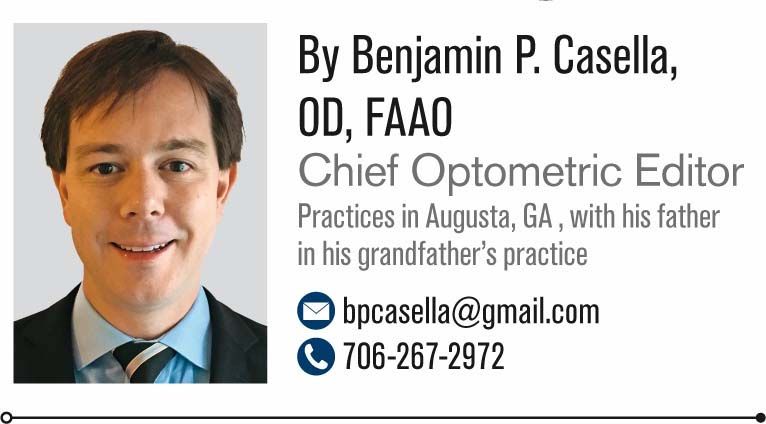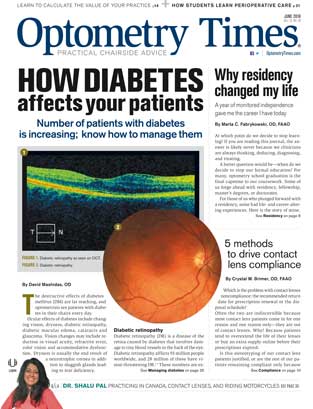How the public perceives optometry
No one else is going to explain what ODs do or how we are important to our communities. It’s our job, and no one else will do it for us.

I expect that within most professions there exists a certain degree of unavoidable subjectivity about how one is perceived by the “general public.” ODs may, from time to time, fall somewhat out of tune with what our patients are encountering in eye care beyond our own practices.
Finger on the pulse
For this reason, every now and then I will peruse the eyecare aisle of a pharmacy or grocery store just to see what our patients are seeing. I look at the over-the-counter readers to see what powers are available, and I look at the shelves to see what companies may be paying more to get their products placed at consumer eye level. I also examine the ingredients of eye health vitamin formulations to see which study with which they correspond.
Of course, any examination of what our patients are experiencing in eye care would be incomplete without an Internet search. So, every so often I search the news with the keyword “optometry” just to see what our patients may be seeing in their day-to-day lives.
Previously from Dr. Casella: Big pharma helps homeless patient
Much of what I come across is positive. For example, I recently came across an uplifting article detailing how the Northeastern State University Oklahoma College of Optometry has a rich history going back decades of caring for the Cherokee Nation.1 Such a compliment to the profession is the care and hard work undertaken by these students and doctors. I also recently came across a piece regarding a Pacific University College of Optometry alumna publishing a book for children going to the eye doctor-Buddy Gets His First Pair of Glasses.2 I’m considering a copy for my reception area.
Negative perception
On the other side of the coin is the cold hard fact that negative news sells. So, it is interesting but not surprising to come across an article alleging that comanagement of cataract surgery by doctors of optometry is putting African Americans at risk for complications.3
ODs are able to read such articles and quickly notice the lack of evidence supporting such claims. However, many of our patients don’t know what they don’t know, and damage can be done.
Anti-optometry propaganda occasionally shows itself in the media, especially in the arena of proposed changes to scope of practice. This can get quite ugly, but I am usually pleased with the professional and positive responses on the part of optometry at a regional, state, and national level. We do not define ourselves by what we are not, but rather what we are: doctors for the human eye and adnexa. As such, we are responsible for informing the public of who we are and what we do. We also expose misinformation for what it is: misinformation.
Media skills
When I was president of the Georgia Optometric Association (GOA), I got a firsthand look at how the GOA informs the public of all the good being done by doctors of optometry across our state. We make use of a media relations firm (Curran Public Relations) in order to fulfill this important task. Dan Curran does a tremendous job of making us look and sound, well, presentable in the media.
Additionally, media relations firms, by definition, have relationships with the media, and they can successfully pitch stories to the best outlets. Besides the fact that Dan likes to get on my case for not wearing a lab coat, he teaches GOA leadership how to approach media and respond to questions. When an interviewer asks a question that is off-task or intended to get an emotional response, the art of politely acknowledging said question and getting seamlessly back to one’s talking points can be tricky and delicate. That is where professionals such as Dan come in handy, and I would urge other state associations that have not yet done so to make use of a media relations company.
It starts with me
So, with all of this in mind, I turn to a more personal task: I want to make a concerted effort to be more of a presence with my local media outlets about who I am as a doctor of optometry and what I do for my patients.
I have been asked to appear on local news shows every now and then to talk about children’s vision before school starts, and the GOA, through use of our media relations firm, has gotten me local spots ranging from safety with fireworks to the dangers of illegally sold contact lenses during the Halloween season. However, I am going to approach these outlets more often as I seek opportunities to talk about who I am and what I do. The worst thing they can say is “no,” right?
Related: Stop, say hello, and shake my hand
I need to come up with a story and an angle that would be well-received by a media outlet, and I’ve got a few in mind:
• There has been (and needs to be) talk about contact lens sales and marketing practices by large retailers around proposed regulations by lawmakers and regulatory entities.
This topic has garnered national attention, but I don’t think I’ve seen much (if any) coverage in the greater Augusta, GA, market (my hometown). I could pitch a story that explains how patient care is of the utmost importance regarding the fitting and prescribing of FDA-approved medical devices such as contact lenses and the important role optometry continues to play.
• Too many people in the general public think that all progressive addition lenses (PALs) are the same. This could be a perfect opportunity for me to speak about the evolution of PALs, the concept of the progressive corridor, and how the science behind these lenses has changed significantly. I may be able to dispel the myth that patients can go elsewhere and get for a fraction of the price the same PALs that I or other ODs recommend. I could also explain how optometry is the profession of vision science. I could manage the conversation to discuss the importance of impact-resistant lenses for children and for sports and expand to include a low vision update.
• Many parents believe that their children reading a visual acuity chart at the pediatrician’s office is a comprehensive eye exam. I could explain the aspects of a comprehensive eye examination, including what we are testing for and guarding against during each step of the exam process.
No one else is going to explain what ODs do or how we are important to our communities. It’s our job, and no one else will do it for us. We continue to have aggressive and successful campaigns on a national level, and many state associations have had similar success. So, why not bring this concept into our local communities? A grassroots approach is behind of our legislative achievements. Let’s utilize it in this arena as well.
If you have had success in your local media market promoting optometry and the good that we do for our patients, I’d love to hear about it. If I succeed in my endeavors, I’ll share it with you (in some medium or another).
Read more from Dr. Casella here
References:
1. Bark L. Cherokees have used NSU optometry clinic for 39 years. Cherokee Phoenix. Available at: http://www.cherokeephoenix.org/Article/index/12187. Accessed 5/3/18.
2. Yokoy J. Pacific Optometry Alumna Tawnya Pastuck Publishes Her First Children’s Book. Available at: https://www.pacificu.edu/about/media/pacific-optometry-alumna-tawnya-pastuck-publishes-her-first-children%E2%80%99s-book. Accessed 5/3/18.
3. Hammond J. African-Americans at risk from unusual optometry practice. Urban News Service. Available at: https://urbannewsservice.com/investigations/african-americans-risk-unusual-optometry-practice-2/. Accessed 4/30/18.

Newsletter
Want more insights like this? Subscribe to Optometry Times and get clinical pearls and practice tips delivered straight to your inbox.